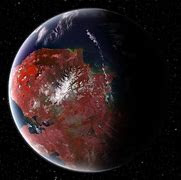Planets That Looks Like Earth...
There are several planets in our solar system and beyond that are known to be similar to Earth in various ways.
In our own solar system, the planet that most closely resembles Earth is Mars. Although Mars is much colder and drier than Earth, it has a similar day length, a similar tilt to its axis, and even has seasons. Mars also has a thin atmosphere that is mostly carbon dioxide, and there is evidence that liquid water exists on the planet.
In addition to Mars, there are several exoplanets (planets outside our solar system) that have been discovered that are similar in size and mass to Earth, and that orbit their stars at a distance that could potentially allow liquid water to exist on their surfaces. These planets are known as "Earth-like" or "potentially habitable" planets, and include Kepler-438b, Kepler-442b, Proxima Centauri b, and TRAPPIST-1d, among others.
However, it is important to note that while these planets may have some similarities to Earth, they also have significant differences, such as their atmospheric composition, surface temperature, and other factors that could make them inhospitable to life as we know it.
some more information about planets that are similar to Earth:
Mars:
Kepler-438b:
Kepler-442b:
Proxima Centauri b:
TRAPPIST-1d:
TRAPPIST-1d is one of seven Earth-sized exoplanets that orbit the star TRAPPIST-1, which is about 39 light-years away from us. The planet is about 0.77 times the size of Earth and orbits its star at a distance that could potentially allow liquid water to exist on its surface.
While these planets may have some similarities to Earth, they also have significant differences that could make them inhospitable to life as we know it. For example, some of these planets may have thick atmospheres that trap heat, while others may be too close or too far from their stars to support life. Scientists are still working to learn more about these planets and their potential habitability.
what is in these planets?
It is not possible to know with certainty what is on other planets without conducting direct observations or explorations. However, based on the available data and scientific models, here's what we currently know or suspect about some of the planets that are similar to Earth:
Mars: Mars is a rocky planet with a thin atmosphere that is mostly composed of carbon dioxide. The planet has polar ice caps made of water and carbon dioxide, and there is evidence that liquid water exists beneath the surface. Mars has a variety of surface features, including craters, canyons, and mountains.
Kepler-438b: Kepler-438b is an exoplanet that is about the same size as Earth. It orbits a red dwarf star and is located in the habitable zone, where temperatures could potentially allow liquid water to exist on the surface. However, because the planet is located about 640 light-years away from us, it is difficult to study in detail.
Kepler-442b: Kepler-442b is another exoplanet that is slightly larger than Earth. It also orbits a red dwarf star in the habitable zone, but it is located about 1,120 light-years away from us, making it difficult to study.
Proxima Centauri b: Proxima Centauri b is an exoplanet that orbits the closest star to our solar system, Proxima Centauri. The planet is about 1.3 times the size of Earth and orbits its star at a distance that could potentially allow liquid water to exist on its surface. However, the planet is likely exposed to intense radiation and solar flares from its star, which could make it difficult for life to survive.
TRAPPIST-1d: TRAPPIST-1d is one of seven Earth-sized exoplanets that orbit the star TRAPPIST-1. The planet is about 0.77 times the size of Earth and orbits its star at a distance that could potentially allow liquid water to exist on its surface. TRAPPIST-1d and the other planets in the TRAPPIST-1 system have been studied in detail by telescopes, and scientists have found evidence of water vapor in the atmosphere of some of the planets.
It's important to note that these planets are still largely a mystery, and our understanding of them is based on limited observations and models. Future space missions and technology may allow us to study these planets in more detail and learn more about their composition, geology, and potential for supporting life.














Comments
Post a Comment